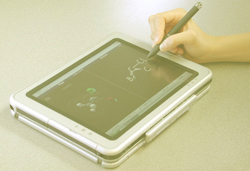
|

|
| Home |
| Mission |
| People |
| Research |
| Publications |
| Downloads |
|
|
|
|
| Project List: |
| starPad SDK |
| ChemPad |
| Fluid Inking |
| Lineogrammer |
| MathPad2 |
| MathPaper |
| Music Notepad |
| ReMarkable Texts |
| SKETCH |
starPad SDK |

|
Download the starPad SDK 0.1.3 |
|
We envision an aggregation of applications that use post-WIMP, pen-centric interfaces to make computational assistance more natural and efficient; among such applications are MathPad2, the Music Notepad, and ChemPad, which are shown in the image above. We originally called that aggregation *Pad, using ‘*’ as a wildcard, but are now calling it starPad for ease of location through search engines.
The goal of the starPad SDK project is to make it easier for people to write these sorts of applications by providing a convenient interface for a broad layer of pen-centric functionality in addition to some research functionality. Currently, it is written for MS Windows .Net and uses WPF. It includes a convenient interface to stroke-level operations, a recognition library for handwritten math and gestures, some UI techniques such as GestureBar, and a pen- and gesture-based application shell supporting selection, undo, zooming, text input, images, and save/load. We are releasing a beta version (0.1.3) of our source tree; the README file includes an overview of the included functionality. Currently, the license that comes with it essentially allows free non-commercial use. The authors disagree as to whether to make the code free for commercial use as well (and thus open-source) and have agreed to postpone the decision until and unless someone actually wants to use it for such a purpose. So, if you want to use our code in a commercial product, please get in touch with us: tsm, bcz, and acb at cs.brown.edu.
For future functionality for this SDK, we are currently investigating the feasibility of externally retrofitting, without altering, running applications with new interfaces and functionality made possible by using a combination of application-independent pixel-level recognition techniques and more specialized techniques for inspecting data structures exposed by the window system or application. Users will be able to make annotations to those running applications, including hand-drawn ink, typed text, diagrams, interactive widgets, or even links to other application user interface components. Registration techniques will then be researched to associate the annotations with specific elements of an application or document so that such an annotation can be made to appear perhaps only in one place in a specific file, or whenever a certain application runs. The facility we are developing would support a variety of practices, including: integrating functionality from different applications, enriched collaboration, task or user customized interfaces, and adding new fine-grained user interface elements to applications. Registration techniques will be supported through such means as using system and accessibility information, optical character recognition and shape recognition techniques for reading bitmaps, and recognizing handwritten ink. We also expect to gain insight into the impact on usability of different levels of artifacts due to imperfection in the registration techniques and heuristics. Additionally, we are planning to investigate prototype extensions to applications that are meritorious in and of themselves, such as universal spell-checking.
|
|
|
|